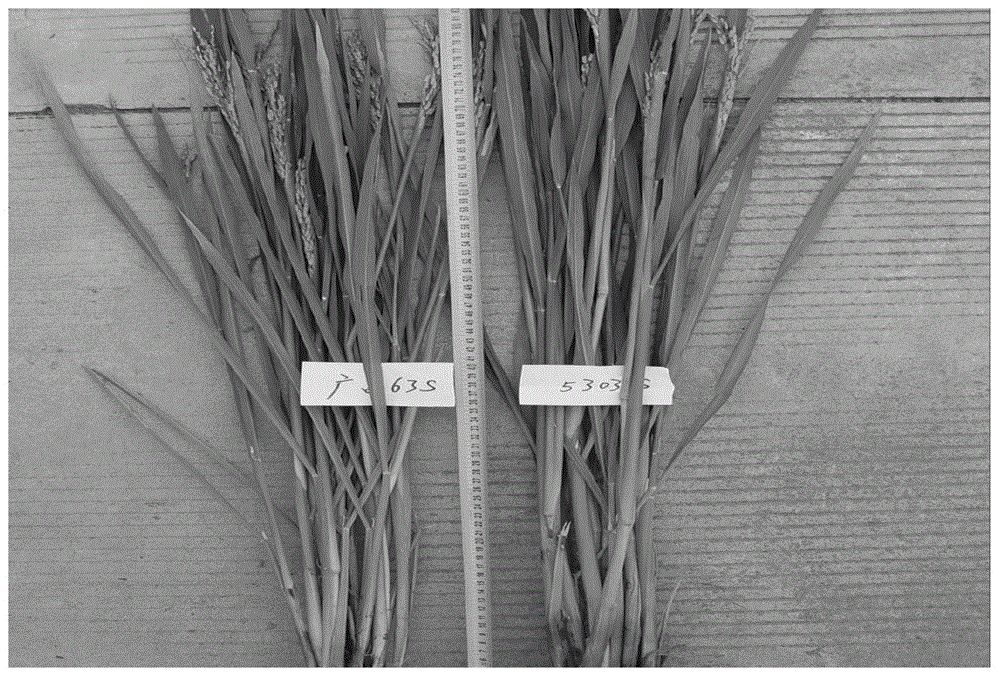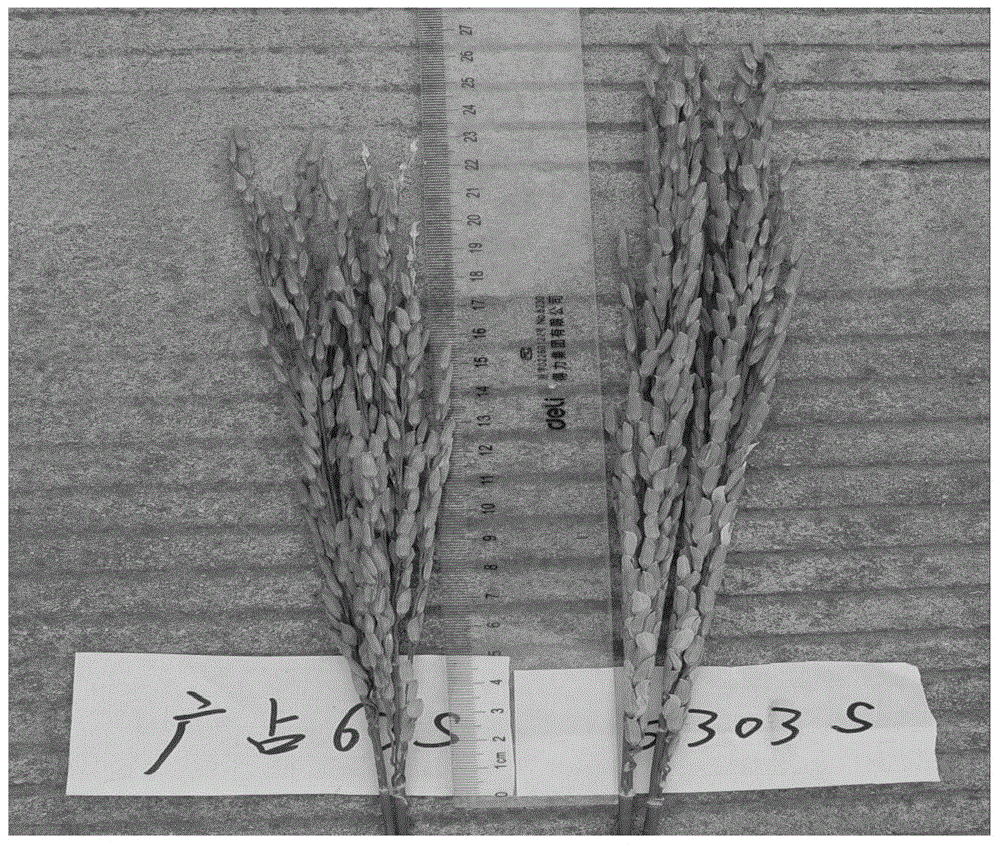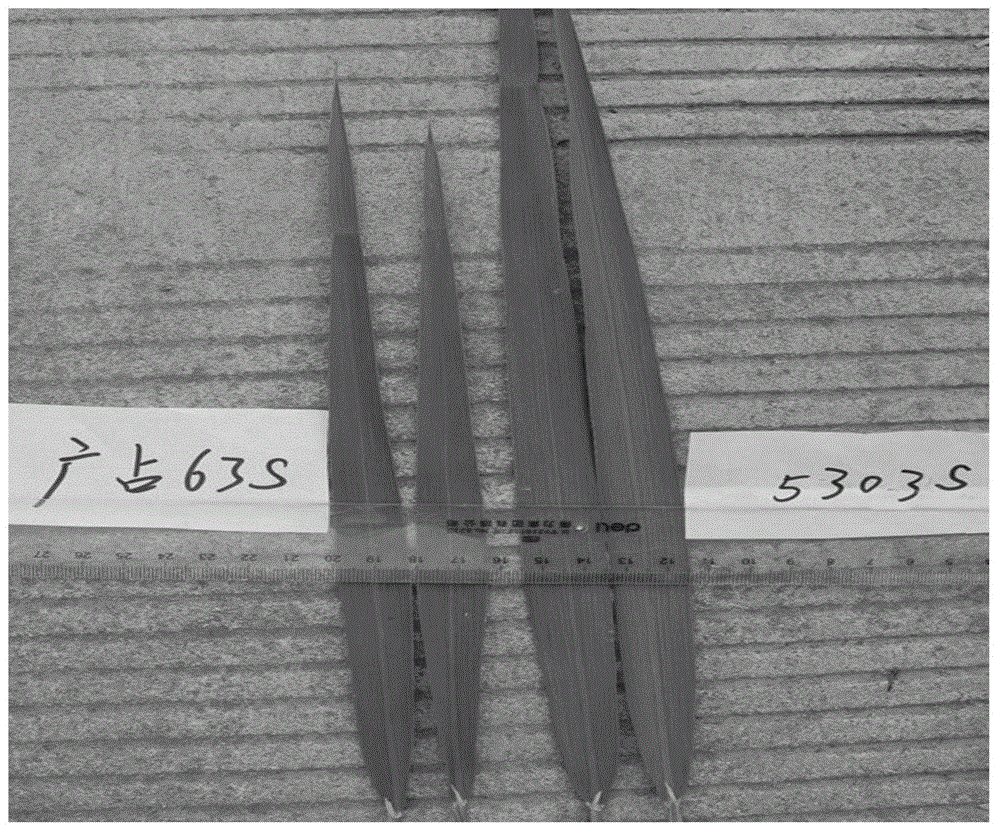Method for breeding shattering-resisting high-yield hybrid rice
A technology of hybrid rice and shattering, which is applied in the direction of botany equipment and methods, application, plant genetic improvement, etc., can solve the problems of long time, a lot of manpower and material resources, etc., and achieve the effect of strong stem, good resistance and low temperature
- Summary
- Abstract
- Description
- Claims
- Application Information
AI Technical Summary
Problems solved by technology
Method used
Image
Examples
Embodiment 1
[0029] (1) In Sanya in the winter of 2004, Guangzhan 63S, an indica temperature-sensitive male sterile line with dense panicle type, compact plant type, short and robust plants, strong lodging resistance, and good outcrossing performance, was selected as the female parent. 5M303, a difficult-threshing self-fertile restorer line with good outcrossing performance, was used as the male parent, and the two were crossed, and 52 F1 seeds were harvested.
[0030] (2) In the summer of 2005, 22 F1 plants were planted in two rows in Hefei, and F2 seeds were obtained by selfing and fruiting.
[0031] (3) In the summer of 2006, 2000 F2 segregation populations were planted in Hefei, and 20 sterile plants with better comprehensive traits such as panicle shape, leaf shape and tillering were selected from them, and the stems were cut to regenerate and retain seeds to obtain F3 generation seeds.
[0032] (4) In the winter of 2006, 20 F3 rows × 22 plants were planted in Sanya, and the traits su...
Embodiment 2
[0044] To compare the self-breeding yield of the difficult-shattering CMS line 5303S and the easy-shattering CMS line Guangzhan 63S, follow the steps below:
[0045] 1) The hard-shattering CMS line 5303S and the easy-shattering CMS line Guangzhan 63S were self-propagated in Sanya in the winter of 2011, and the planting size was 6.67m 2 , and set three repetitions, according to normal field management.
[0046] 2) At the maturity stage, the paddy is hard, and more than 90% of the spikelets are mature. Take 10 paddy spikes and air-dry them, place them at a height of 1.5m, drop them horizontally, and drop them onto the ground with an iron plate. Operate continuously for 3 times, and measure the shattering. Rate.
[0047] 3) Harvest when the paddy is mature, weigh the yield, and take the average value. The results are shown in Table 1.
[0048] Table 1. Comparison of self-breeding yield of the hard-threshing CMS line 5303S and the easy-shattering CMS line Guangzhan 63S
[0049]...
Embodiment 3
[0053] Comparing the agronomic traits of the hard-shattering CMS line 5303S and other CMS lines respectively prepared in hybrid combinations, the following steps were implemented:
[0054] 1) In the winter of 2011 in Sanya, the difficult-threshing CMS line 5303S and the easy-shattering CMS line Guangzhan 63S were selected as test materials, respectively, and the restorer line 2M128, which was easy to shatter, were used for small-scale seed production in Sanya, Hainan, and hybrid combinations were prepared .
[0055] 2) In the summer of 2012, the plot was planted in Hefei according to the size of 11×15, and the planting size was 6.67m 2 , and set three repetitions.
[0056] 3) At the maturity stage, the paddy is hard, and more than 90% of the spikelets are mature. Take 10 paddy spikes and air-dry them, place them at a height of 1.5m, drop them horizontally, and drop them on the ground with an iron plate. Operate continuously for 3 times, and measure each combination shatterin...
PUM
 Login to View More
Login to View More Abstract
Description
Claims
Application Information
 Login to View More
Login to View More - R&D
- Intellectual Property
- Life Sciences
- Materials
- Tech Scout
- Unparalleled Data Quality
- Higher Quality Content
- 60% Fewer Hallucinations
Browse by: Latest US Patents, China's latest patents, Technical Efficacy Thesaurus, Application Domain, Technology Topic, Popular Technical Reports.
© 2025 PatSnap. All rights reserved.Legal|Privacy policy|Modern Slavery Act Transparency Statement|Sitemap|About US| Contact US: help@patsnap.com



